With its beautiful landscapes and timeless charm, Italy is home to some of Europe’s most enchanting hill stations. Set amid rolling vineyards, cypress-lined lanes and centuries-old villages, the hill stations in Italy provide a peaceful escape from the big cities and coastal crowds. Whether you’re looking for sweeping views of the Tuscan countryside, a charming lakeside view in the north, or a medieval settlement perched on the top of dramatic cliffs, Italy offers a great blend of natural beauty, rich history, and culture. Many of these towns still uphold genuine Italian traditions with local festivals, rustic cuisine, and handcrafted crafts.
10 Best And Must-Visit Hill Stations In Italy
Stroll through the romantic streets of Orvieto or soak in the alpine charm of Asiago; these delightful destinations are just right for slow travel and meaningful exploration.
1. Cortina D’Ampezzo
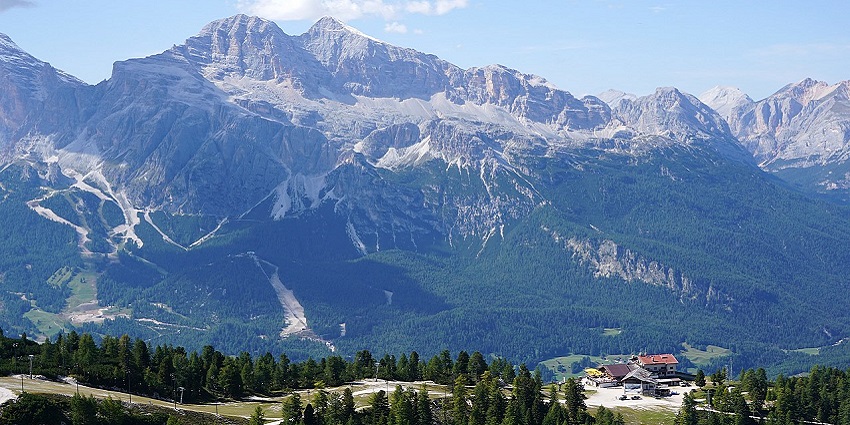
Photo: kallerna / Wikimedia Commons
Famous for its luxury ski circuit and designer boutiques, Cortina also has a vibrant cultural history as part of the ancient Ladin territory. Standing at 1,224 metres (4,049 feet) above sea level, it has refreshing views of jagged limestone peaks and rich alpine valleys. The town held the 1956 Winter Olympics and will co-host the 2026 Games, leaving an enduring legacy in alpine sports. In winter, it has more than 120 kilometres of ski slopes with diverse terrain for beginners and expert skiers. Snowshoeing, ice climbing and cross-country skiing in the Ampezzo Dolomites Natural Park off the pistes provide quieter, scenic options. This, like other hill stations in Italy, also has high-end spas, art galleries and gourmet restaurants for rest days.
Location: Veneto, in the Dolomites (Northern Italy)
Best Time To Visit: December to February; June to September
Nearby Attractions: Tre Cime di Lavaredo, Lake Misurina, Faloria cable car
2. Bormio
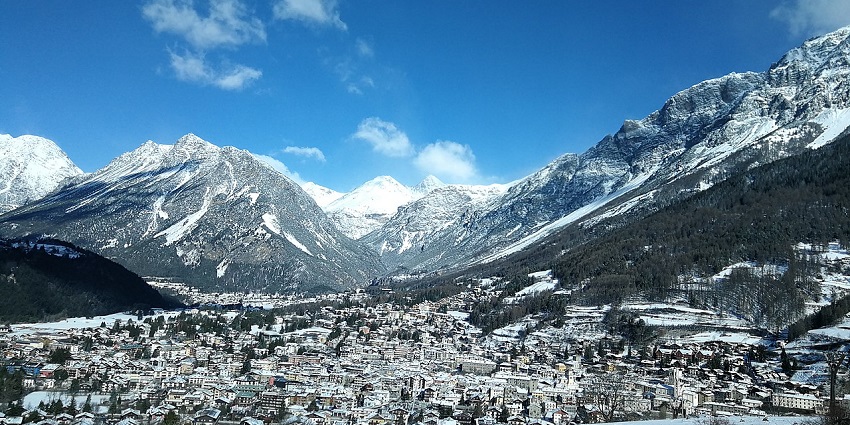
Photo: Sauro Sisti / Wikimedia Commons
The historic spa town of Bormio perches at 1,225 meters, surrounded by soaring Alpine peaks, steeped in Roman roots and centuries of thermal tradition. Its medieval old town, with cobbled alleys and frescoed façades, lends an old-world charm to a destination known for wellness and winter sports. Bormio has the renowned Bagni Vecchi and Bagnin Giovi thermal baths that pass through Roman tunnels and cliffside pools looking out over the valley. In the winter, Bormio 2000 and Bormio 3000 ski areas offer more than 50 km of pistes, including the Stelvio downhill, which is one of the most demanding technical courses in World Cup alpine racing.
Location: Lombardy, in the Alps near the Swiss border
Best Time To Visit: December to March; June to September
Nearby Attractions: Stelvio Pass, Bagni Vecchi thermal baths, Stelvio National Park
3. Merano
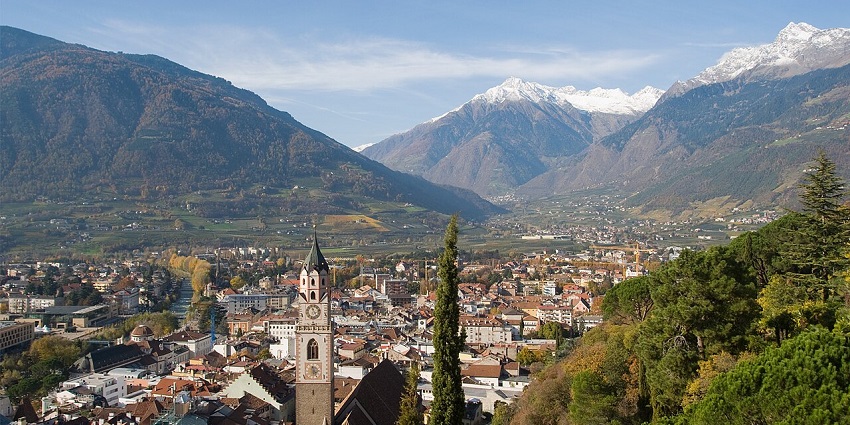
Photo: Noclador / Wikimedia Commons
Merano is a unique cross-section of hill stations in Italy between Alpine and Mediterranean, set among vineyards, palm trees and snow-capped mountains. It was founded during Empress Sissi’s sovereignty and features belle époque architecture, thermal baths and groomed promenades like the Passer River Walk. The city is known for its mild climate and the botanical gardens at Trauttmansdorff Castle, home to exotic and native plant species. It is often thought of as a wellness destination, but it also provides a fantastic and beautiful base for outdoor activities. The nearby Merano 2000 ski area features well-groomed slopes and sweeping views, and snowshoeing offers a quieter alternative..
Location: South Tyrol, Northern Italy
Best Time To Visit: April to June; September to October
Nearby Attractions: Trauttmansdorff Castle Gardens, Tappeiner Promenade, Merano Thermal Baths
4. Aosta
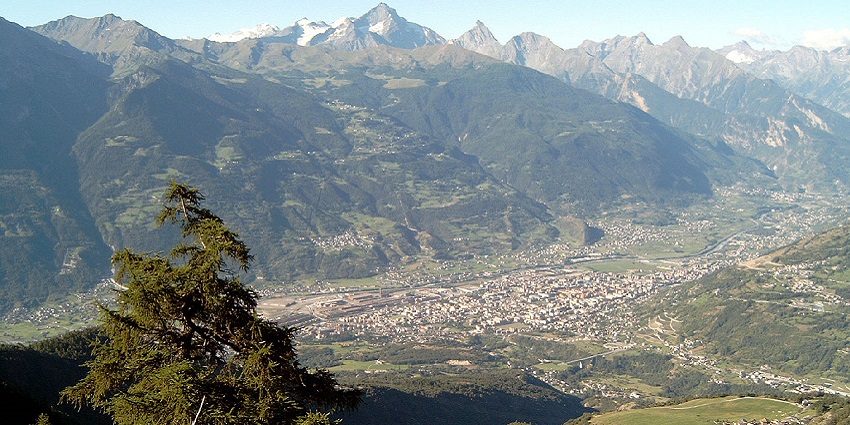
Photo: Tinelot Wittermans / Wikimedia Commons
Aosta is notable for its extraordinary Roman legacy and mountain-town atmosphere, surrounded by some of the Alps’ highest peaks. The city centre has many Roman features with ancient gates and forums, which makes it like an open-air museum rather than a hill town. Its architecture mixes medieval stone towers and Alpine chalets in a unique backdrop for exploration. Aosta is also a base for outdoor activities throughout the year. In winter, ski areas, including Pila, can be reached by gondola from the city and see the views of the Matterhorn and Mont Blanc. Other popular activities in the side valleys include off-piste skiing, ice climbing and alpine touring. Hikers flock here in summer, trekking through larch forests, past waterfalls and alongside ibex to the Gran Paradiso National Park.
Location: Aosta Valley, Northwestern Italy
Best Time To Visit: Year-round
Nearby Attractions: Gran Paradiso National Park, Roman Theatre of Aosta, Skyway Monte Bianco
5. Madonna Di Campiglio
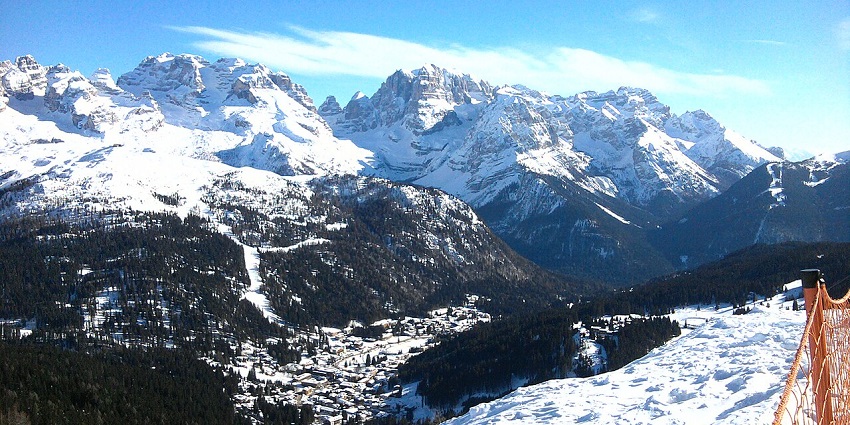
Photo: Marypozzi / Wikimedia Commons
Madonna di Campiglio balances luxury with mountain sports, all set amidst the jaw-dropping Brenta Dolomites. The town centre retains its Belle Époque character, and the place is home to international ski competitions and a polished après-ski scene, including wine bars and wellness spas. With an elevation of 1,550 metres, it is part of the Skirama Dolomiti network, with access to more than 150 kilometres of ski runs connected to Pinzolo and Folgarida. There are slopes for every level at Grostè and Spinale, and the Canalone Miramonti black run is considered the best among experts. In winter, the region also has snowmobile safaris, ice karting, and trails through snow-covered forests.
Location: Trentino-Alto Adige, Dolomites
Best Time To Visit: December to March; July to September
Nearby Attractions: Adamello Brenta Nature Park, Lake Nambino, Cascate Vallesinella
6. San Martino Di Castrozza
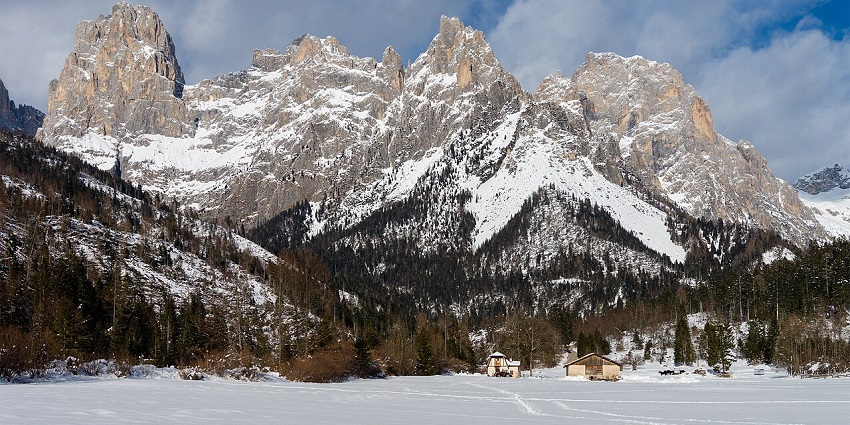
Photo: Marco Ober / Wikimedia Commons
San Martino di Castrozza is backed by the gorgeous Pale di San Martino massif, whose vertical walls turn pink at sunrise and sunset. The town itself is small but well-balanced, with classic alpine lodging and wide terraces with unimpeded views of the Dolomites. At 1,487 metres, it is the main access point to the Paneveggio-Pale di San Martino Natural Park, with larch forests, high-alpine plateaus and wildlife. During winter, 60 km of pistes are available, with family-friendly slopes sitting alongside more challenging descents near Tognola and Colverde. Cross-country skiing and snowshoeing trails snake through the quiet forests, and guided alpine tours provide access to untracked backcountry. In summer, the world-famed Pala traverse and the glacier-fed lakes of Val Venegia are dramatic hiking options. Climbers ascend classic Dolomitic faces, and mountain bikers ride on single tracks through alpine meadows.
Location: Trentino, Eastern Dolomites
Best Time To Visit: June to September; December to March
Nearby Attractions: Pale di San Martino range, Paneveggio Forest, Rolle Pass
7. Courmayeur
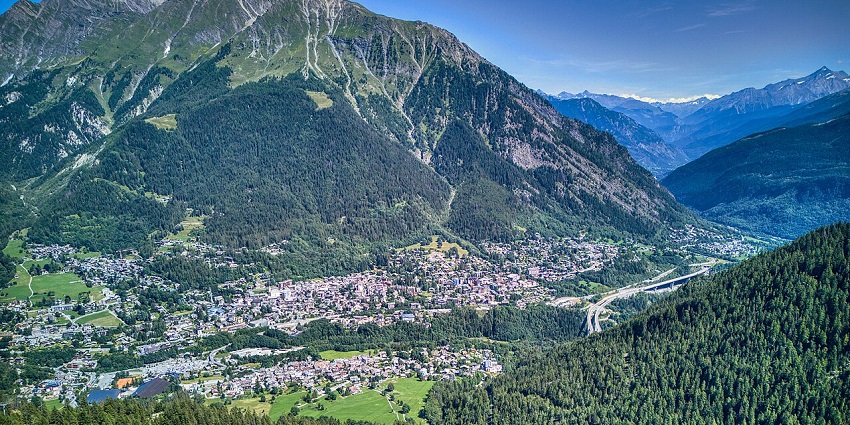
Photo: Hagai Agmon-Snir / Wikimedia Commons / Image For Representation Only
One of the alpine destinations among hill stations in Italy, Courmayeur is a polished town at the base of Monte Bianco. It has cobbled streets, high-end boutiques and old stone buildings that reveal its mixed Franco-Italian heritage. The vibe is upscale with a lively après-ski scene focused on wine bars and slow-food restaurants. It has over 100 kilometres of slopes, many of them in sunny south-facing bowls and treed runs that are perfect for intermediate skiers. Freeskiing is world-renowned here, notably the Vallée Blanche descent accessed via the Skyway Monte Bianco cable car, a dramatic 20 km glacier run. In summer, Courmayeur serves as a base for hiking the Tour du Mont Blanc circuit and alpine trekking to remote refuges such as Bertone or Bonatti.
Location: Aosta Valley, near Mont Blanc
Best Time To Visit: December to March; July to September
Nearby Attractions: Mont Blanc Skyway, Val Ferret, Alpine botanical garden Saussure
8. Ortisei, St. Ulrich
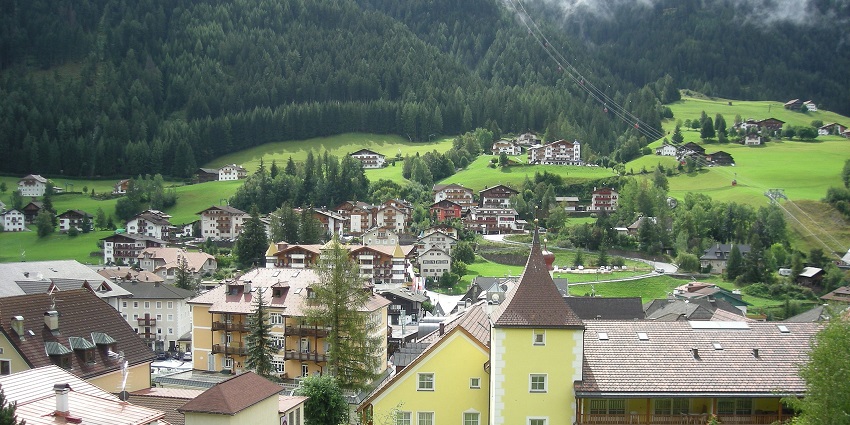
Photo: L3O / Wikimedia Commons
Ortisei, also known in Ladin as St. Ulrich, is a postcard village famous for its woodcarving heritage and colourful Tyrolean culture. Framed by the dramatic peaks of the Seceda and Rasciesa ridges, it provides beautiful views from every angle. The town’s flower-draped balconies, artisan shops, cosy cafés, traditional bakeries, and quaint churches are a window into an ingrained local identity. In winter, Ortisei also connects to the Dolomiti Superski domain and the Alpe di Siusi and Seceda ski areas, which are perfect for scenic riding and long descents. Cross-country skiing and snowshoeing are also popular, with panoramic routes through snowy plateaus.
Location: Val Gardena, South Tyrol
Best Time To Visit: June to September; December to March
Nearby Attractions: Seceda and Alpe di Siusi, Dolomiti Superski, Museum Gherdëina
9. Brunico, Bruneck
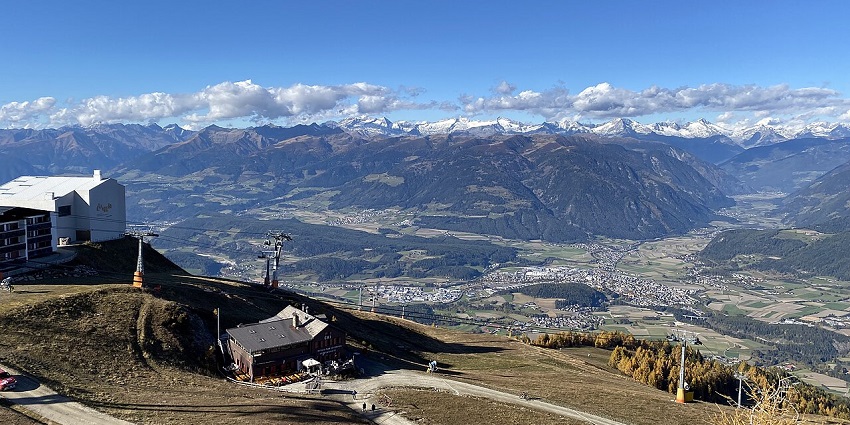
Photo: wuppertaler / Wikimedia Commons
Brunico, or Bruneck in German, is a lively alpine town that combines medieval heritage with a vibrant mountain life. The old town is dominated by its 13th-century castle and pastel-painted buildings. The town centre bustles with bakeries, bookshops and Tyrolean taverns. Brunico is the main hub of skiing at Plan de Corones (Kronplatz), a modern resort with 120 km of wide, impeccably groomed runs and top lift infrastructure. This, out of other hill stations in Italy, is also the site of the Lumen Museum of Mountain Photography and Reinhold Messner’s Corones museum, which juts dramatically from the sheer ridge at 2,275 metres.
Location: South Tyrol, Puster Valley
Best Time To Visit: December to February; July to September
Nearby Attractions: Plan de Corones, Messner Mountain Museum, Brunico Castle
10. Sestriere

Photo: Lucas130999 / Wikimedia Commons / Image For Representation Only
Sestriere is a high-altitude alpine resort 2,035 metres up, built by Fiat’s Agnelli family in the 1930s as an intended purpose-built ski holiday destination. It has since formed the backbone of the Via Lattea (Milky Way) ski circuit, which links more than 400 kilometres of pistes in Italy and over the border into France. Its altitude guarantees reliable snow and diverse terrain, from easy-going slopes to Olympic-standard descents like Kandahar Banchetta. Sestriere held major events as part of the 2006 Winter Olympics and also hosted international competitions. The town itself is more than charming, with ski-in/ski-out lodging and lift access. Besides skiing, you can try night skiing, snowmobile excursions and ice skating.
Location: Piedmont, Western Alps
Best Time To Visit: December to March; June to September
Nearby Attractions: Lattea ski area, Chisone Valley, Fenestrelle Fort
Hill stations in Italy bring an intense, immersive sense of Italy’s structured history and regional character. Each destination is shaped by the land and centuries of tradition and has its own rhythm. Whether you’re meandering through cobblestone lanes, sipping wine on a sun-drenched terrace or hiking through alpine meadows, these high towns bring tranquillity and beauty. If you are looking for a slower pace and real charm, away from overcrowded cities, discover hill stations in Italy with TripXL.
Cover Photo: Wolfgang Moroder / Wikimedia Commons / Image For Representation Only


 WhatsApp
WhatsApp
 Twitter
Twitter









